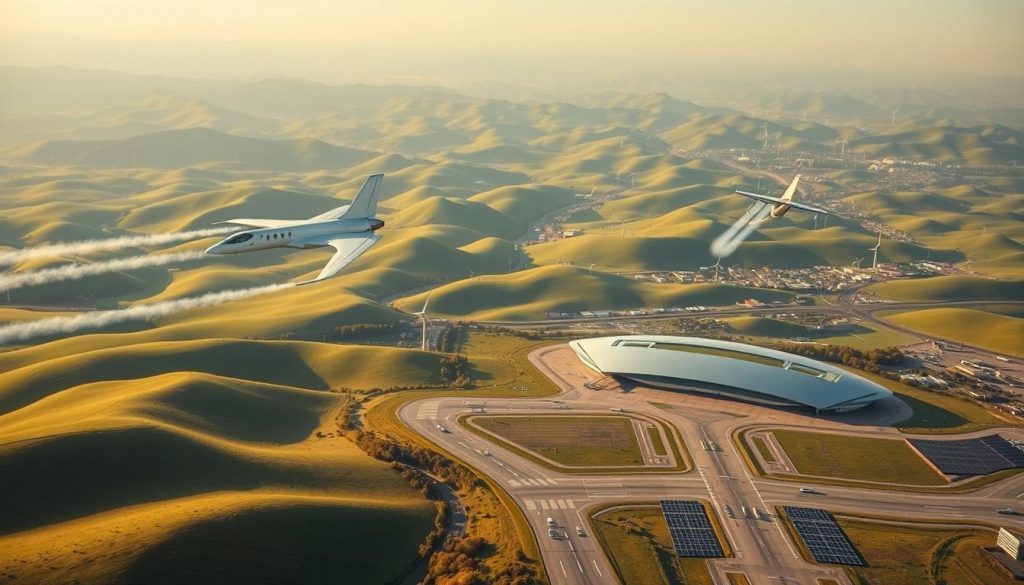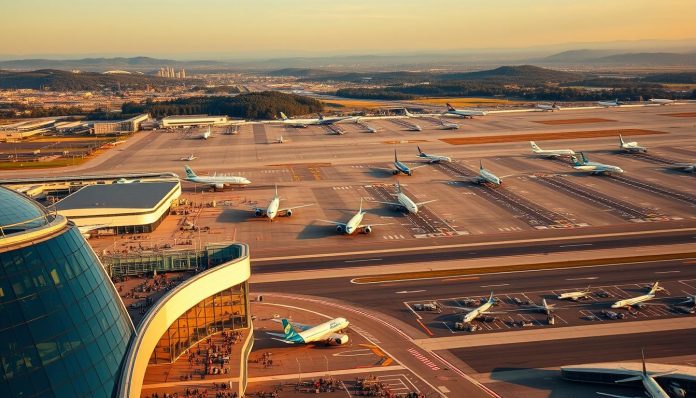What happens when growth ambitions meet urgent climate limits?
This article frames a central conflict: recent approvals for a second runway at Gatwick, a possible third runway at Heathrow, and new capacity at Luton sit against rising aviation emissions flagged by the Climate Change Committee, highlighting the need to adhere to the carbon budget.
Policy choices matter now. A government SAF mandate is only 2% this year, rising to 10% by 2030, while aircraft efficiency and future hydrogen or electric planes will not erase mid-term emissions, especially as passenger numbers continue to grow.
Readers will see how airport expansion is justified by jobs, connectivity, and economic momentum, yet faces tough tests from legally binding carbon targets that will include international flights from 2033, complicating proposals for the third runway at Heathrow.
This introduction previews a route through The Core Conflict, The Case for Expansion, The Case Against Expansion, Jet Zero strategy analysis, and an evidence-led verdict on whether policy, technology, and price signals can align with long-term climate goals and sustainable production practices.
Key Takeaways
- Approvals for new runways raise capacity by hundreds of thousands of flights a year.
- Aviation emissions rose recently, increasing pressure on carbon targets.
- SAF scaling and pricing policy will be central to any reconciliation.
- Tech gains help but are not a near-term fix for long-haul flights.
- The verdict will weigh economic benefits against climate commitments.
Future Outlook: The Core Conflict Driving UK Airport Expansion and Net Zero
Airport growth ambitions are colliding with binding climate duties in a way that will define policy for years. Gatwick’s approved second runway could add roughly 100,000 flights a year, while Heathrow’s runway plans might add about 276,000 if authorised. Luton has also received expansion approval, increasing airport capacity across the system.
What’s approved and what’s next
The government supports Heathrow expansion to boost economic growth and connectivity, with Chancellor Rachel Reeves backing work on a third runway while stressing alignment with climate obligations. Yet the Climate Change Committee warns that more capacity risks breach of carbon budgets unless deeper cuts occur elsewhere.
Emissions, carbon budgets, and sector pressure
UK aviation emissions rose 9% last year, driven by international leisure demand. From 2033, carbon budgets will include international aviation, so any increase in flights increases carbon impact. SAF mandates rise slowly, and aircraft efficiency helps, but planes still burn kerosene for years.
Read more on how airport expansion conflicts with emissions targets via this analysis.
The Case for Expansion: Economic Growth and Connectivity
Backers claim new air links and better freight handling will boost exports and local employment, contributing positively to the UK economy. Supporters say added capacity could draw investment, improve route diversity, and strengthen business clusters near major hubs, as highlighted in recent uk economy news.

Jobs, trade, and investment: making Britain “the world’s best connected place to do business”
The government argues a new runway would boost economic growth by creating construction roles, long-term airport jobs, and service-sector positions.
Improved connections can attract high-value trade and inbound tourism, supporting wider supply chains.
Airport capacity, competition, and regional connectivity
Infrastructure upgrades—terminals, surface access, freight facilities—amplify impact by allowing more flights and better slot use for long-haul markets.
Increased competition between airports may reduce congestion and pressure fares on some routes. That can benefit regional businesses and exporters that rely on time-sensitive cargo.
“There is limited headroom for aviation growth within emissions limits.”
Policy tools—coordinated planning, demand management, and rail links—can spread gains while managing emissions. Expansion’s economic appeal is tangible, yet its long-term impact depends on parallel progress in efficiency and cleaner fuels.
Can the UK Achieve Net Zero and Expand Airports Too? The Climate Challenge and “Jet Zero” Strategy
Policy choices on fuel mandates, pricing, and infrastructure will determine whether extra flights can sit within carbon budgets.

Sustainable aviation fuels: mandates, costs, and the revenue certainty mechanism
The Jet Zero plan treats sustainable aviation fuels as the only scalable near-term lever, integrating sustainable technology into its framework. A mandate rises from 2% this year to 10% by 2030 and 22% by 2040.
A proposed revenue certainty mechanism would underwrite producers with a floor price. That incentive is likely paid via levies on fuel suppliers and passed to passengers as higher ticket costs.
Technology timelines: electric and hydrogen aircraft versus near-term kerosene reality
New aircraft models deliver 15–20% better fuel efficiency, yet efficiency gains alone fall short of targets, as highlighted in the latest sustainability news.
Electric and hydrogen planes face long certification and infrastructure lead times, especially for long-haul routes. Kerosene will power many flights for years.
Managing demand: pricing, rail substitution, and policy trade-offs
Shifting short-haul passengers onto rail could cut aviation emissions, a key topic in sustainability news uk. But flights often stay cheaper because of tax rules, and many travelers choose speed over cost.
Demand-side measures—higher levies, slot controls, or rail upgrades—work but meet political resistance.
Carbon budgets, aviation emissions, and engineered removals: who pays?
The Climate Change Committee warns that aviation emissions risk breaching carbon budgets unless offsets or cuts appear elsewhere.
“Aviation may need to fund permanent engineered removals to balance residual carbon.”
Questions remain: will airlines, passengers, or taxpayers shoulder removal costs? Choices will shape fairness and competitiveness.
| Factor | Short-term effect | Medium-term effect | Cost bearer |
|---|---|---|---|
| SAF mandate | Higher fuel costs | Scale-up of supply | Passengers / fuel suppliers |
| New aircraft | 15–20% efficiency | Gradual fleet turnover | Airlines |
| Electric/hydrogen tech | Limited short-haul pilots | Possible long-haul adoption after 2040 | Government & industry |
| Demand measures | Reduced short trips | Less pressure on carbon budgets | Passengers / regulators |
Verdict: reconciliation is possible but not automatic. It needs urgent mandate execution, rapid sustainable aviation scale, clear signals for airports to upgrade infrastructure, and honest decisions on who pays for residual carbon.
Conclusion: Can the UK Achieve Net Zero and Expand Airports Too?
Policy must force runway projects to match funded, verifiable decarbonisation milestones.
So, can they? The verdict: runway approvals—including a third runway at Heathrow—should only proceed if tied to a credible, funded decarbonisation plan that meets carbon budgets and aligns with the necessary proposals for sustainable growth in the economy.
Sustainable aviation fuels must scale fast via a revenue certainty mechanism so investment flows and costs are shared transparently between the sector and passengers, ensuring that the number of emissions stays within the agreed pathway.
Approvals should be phased, with triggers to pause expansion if emissions exceed pathway limits. The climate change committee must review final plans before consent, particularly in relation to new technologies that could support these efforts.
That path lets the government and figures like Rachel Reeves back growth while keeping climate law on track. Without strict conditions, more capacity risks costly emissions and reputational damage, which would need to be carefully managed.
For more sustainability articles, please follow the link


